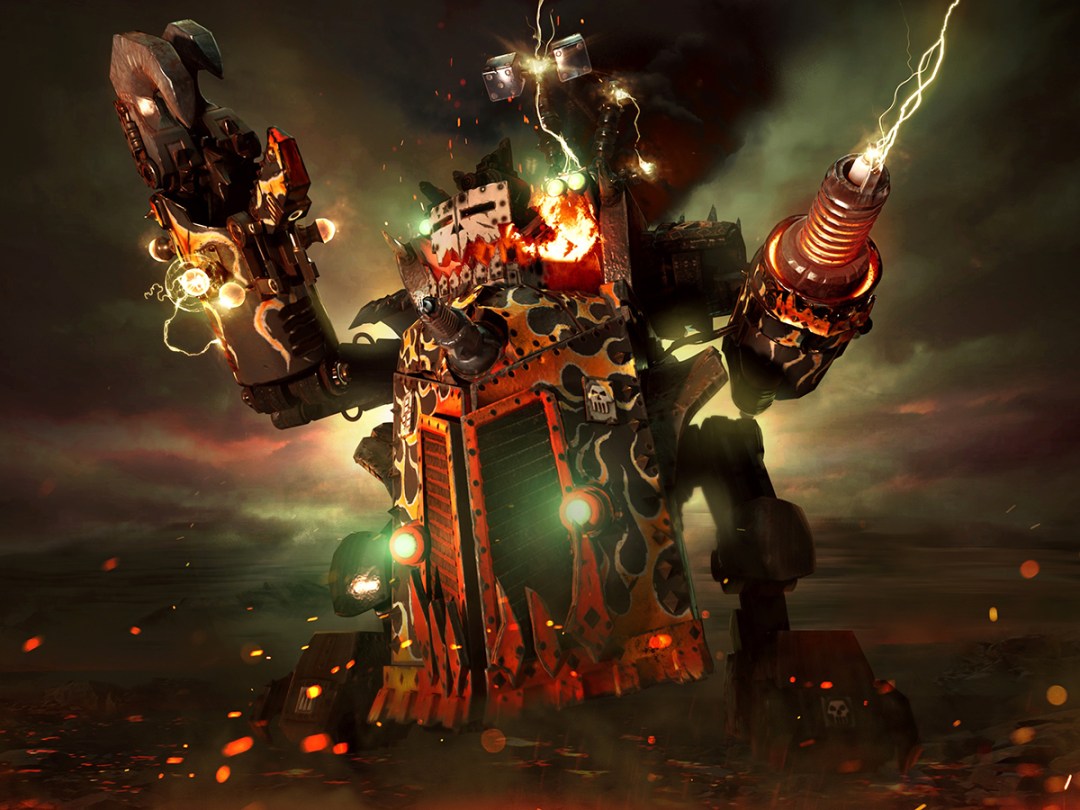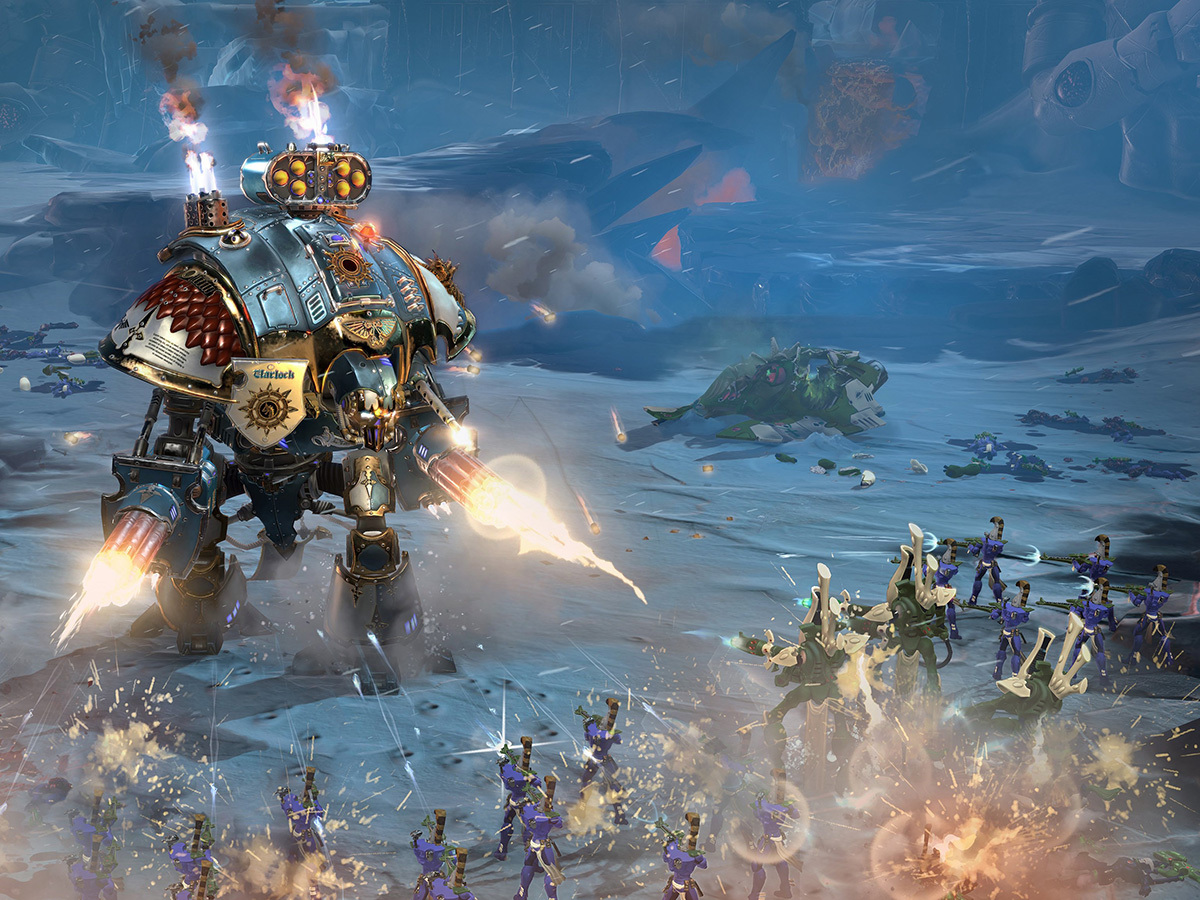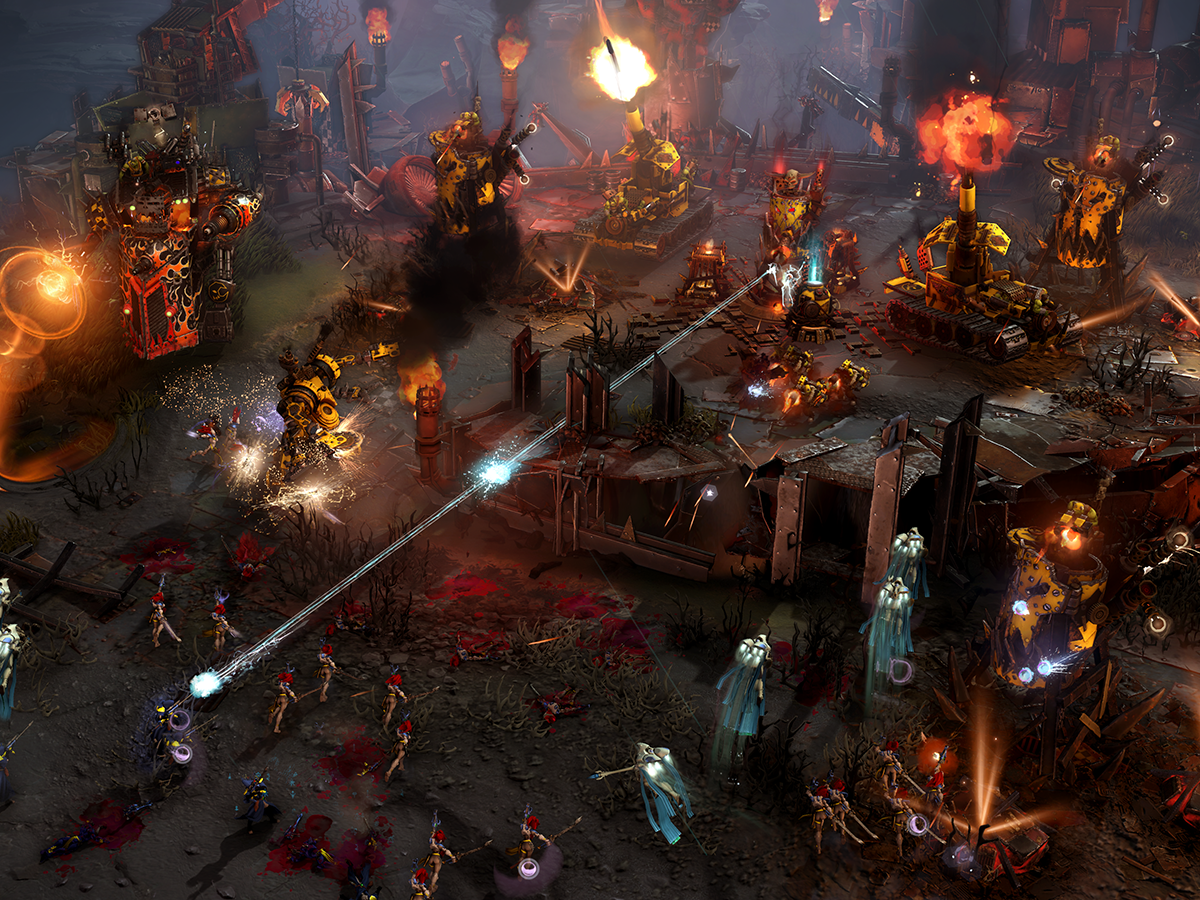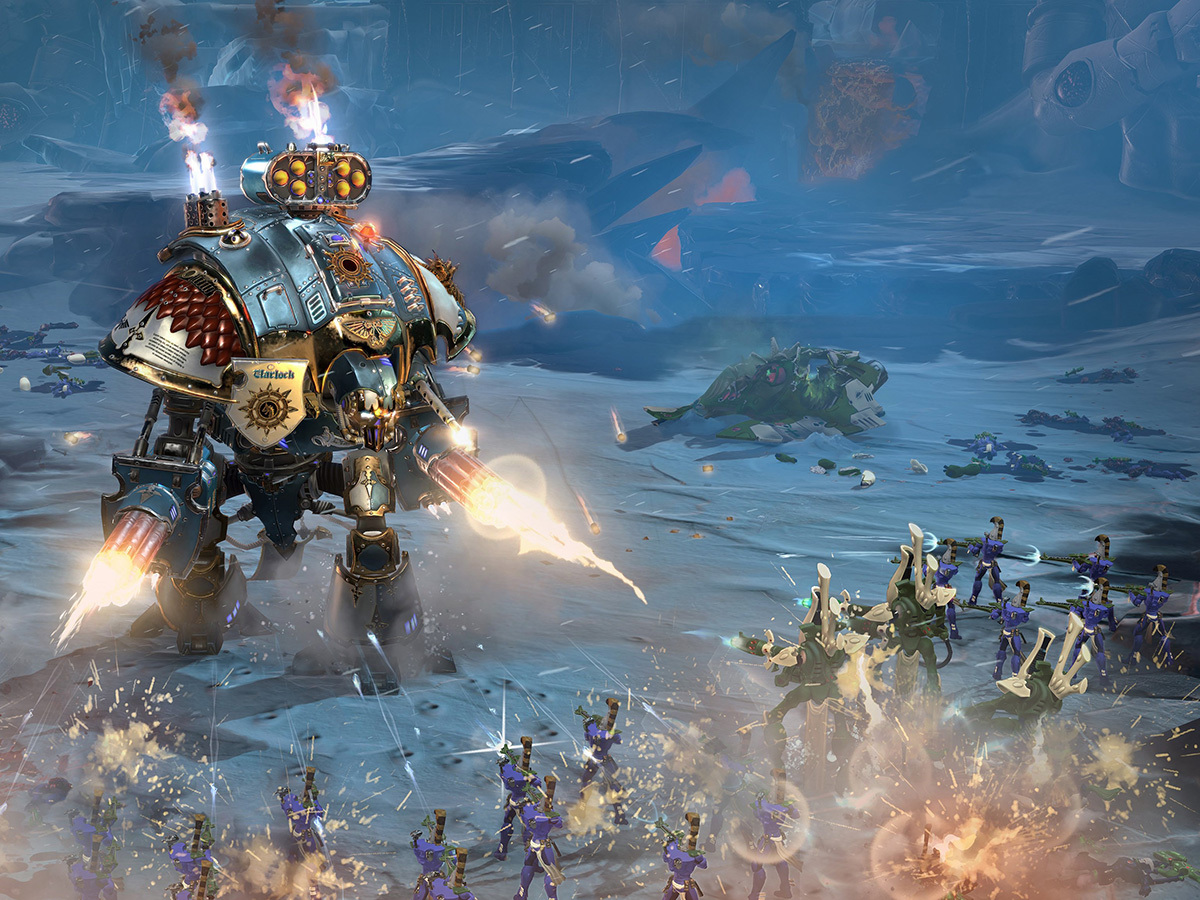Warhammer 40,000: Dawn of War III review
Waaargh! Huuugh, haaagh! What is it good fooor?

A rampaging horde of green-skinned Orks has just carved up your entire front-line army, and is charging towards your only remaining base. There’s no time to reinforce your last few squads of battered Space Marines – better hit that restart button and try again, right?
Not when you’ve got Imperial Knight Solaria waiting in an orbital drop pod, you don’t. Calling down this 40ft walking behemoth of a battle mech can instantly turn the tide of any fight, with giant battling guns that’ll turn marauding savages into nothing but red mist.
Welcome to Dawn of War III.
Developer Relic’s third Warhammer RTS outing takes the best bits from the previous two entries in the series, mashes them together, and ramps up the carnage to almost ludicrous levels. This hybrid style doesn’t always hit the mark, but it’s still a refreshing change of pace from the current crop of League of Legends-style action strategy games.
Been hankering for a traditional top-down RTS? This’ll scratch that itch.
THE RACE IS ON
Dawn of War III marks the first time you’ve been able to play as either Orks, Eldar or Space Marines from the off, instead of waiting for pricey expansions and DLC. All three Warhammer: 40,000 stalwarts have their own place in the single-player campaign, and are fully unlocked for multiplayer mayhem out of the box.
Strategy newcomers should feel right at home with the Space Marines. These gun-toting, chainsword-wielding religious zealots see a square peg and a round hole, and hammer that peg into place with an orbital drop-pod. Build up enough resources and you can fill these pods with assault infantry, battle tanks or the hulking Dreadnought war machines, then fire them down to any point on the battlefield.
The Eldar are much weaker, but have regenerating shields that keep you safe enough to pull daring hit-and-run attacks, and warp tunnels that let you zip around the battlefield. Orks need to get up close and personal to do any real damage, but have the sheer numbers to throw wave after wave of cheap units at your enemy until you break them down.
You aren’t given the chance to settle into one race, though. The campaign pinballs you between all three, forcing you to experiment with new units as they unlock with each new level, before taking them away for an hour or so.
Eventually you’ll settle on a decent mix of melee and long-range infantry, so you’ll be able to take on most fights head-on – just don’t let the enemy get too close. A long-distance Heavy Bolter isn’t much good against Eldar warriors that get right up in your face.
ONE UNIT ARMY

It sounds a lot like the familiar Rock-Paper-Scissors style of RTS play, but isn’t quite that simple. Each unit has a place on the battlefield, and you’ll need a mix of them if you don’t want to take a pounding the minute you encounter some enemy troops with a better unit composition.
Or, you could just call in one of the new Elite units and take on the world like a futuristic space Rambo.
Elites act less like traditional RTS units and more like the hero characters from MOBAs such as League of Legends and Heroes of the Storm.
They’re far more powerful, have unique abilities, and can take a real licking from weaker units before eventually going down. Oh, and they’ll ruin your day if you’re on the receiving end of a beating from one in the multiplayer mode.
Space Marine commander Gabriel Angelos might look like a bit of a wally for bringing a giant hammer to a gunfight, but it hits so hard it’ll literally fling smaller units across the map – if they don’t simply explode in a shower of gore. It doesn’t matter if a squad of long-range snipers see him coming – he’s got enough health (and a terrain-covering leap) that’ll close the gap before they’ve managed to get a few shots off.
This is great in the campaign, letting you roam around each map dishing out damage while lesser units hold the fort back at home, but they can completely negate any kind of strategy you had going in a multiplayer match.
LAND GRAB

It’s a good job, then, that you’ve actually got to earn Elite points to unlock the truly powerful end-game units. Even basic units have to be researched and unlocked back at your base, using power and requisition.
This resource management was removed almost entirely from Dawn of War II, but makes a welcome return here. It turns every match into a constant land-grab, forcing you into small skirmishes over Requisition points, instead of encouraging turtles that like to upgrade and defend until they’ve got a game-winning army.
These points are scattered around each map, and slowly generate power and requisition once you’ve stuck a flag in one. Lose ‘em and your economy gets starved, but control enough and you’ll be able to call on those all-important Elites.
It’s not an easy task, though, now that you don’t get defence bonuses for placing your units in cover. Relic giveth, but Relic also taketh away. This long-standing series mechanic made sense, as it was intrinsic to the Warhammer tabletop game, and, while ditching it has sped up combat quite a lot, fans of the previous games will be disappointed to see it go.
PURGE THE XENOS
The campaign tries to prepare you for these major gameplay changes – it’s just a shame it happens at such a glacial pace. Each new level might have one or two cool, unique set-piece moments, and drip-feed you Elite units to learn and master, but the actual story drags its feet.
Most missions are split into two parts; the first sees a handful of squads and an Elite unit or two trekking across the entire map, while the second half adds some base-building into the mix and settles into a familiar RTS rhythm.
Unlockable ‘doctrines’ that add a few handy extra abilities to your chosen race are a nice touch that’ll keep you playing until you’ve unlocked them all, but for the most part it doesn’t feel as flexible or non-linear as Dawn of War II‘s customisable gear system. Most battles descend into the same familiar units and Elites, so you’ll be itching for something different by the time you see the credits roll.
To the multiplayer mode, then. If you’ve played a MOBA before, you’ll feel right at home: in either 1v1, 2v2 or 3v3 skirmishes, you’ll get a Power Core to defend and a Shield Generator that keeps it safe. Lose the generator and your Power Core is defenceless. Some of the maps even have MOBA-inspired lanes to funnel you towards the enemy base. You’ve got the same base-building and infantry units you had in the campaign, only it all essentially becomes cannon fodder once Elite units hit the battlefield.
It’s fun, no question, but I’m not sure you can call it “strategy”.
That doesn’t mean matches are over in a flash, though. Some take much longer than 30 minutes, which feels a little slow compared to the fast-paced games of StarCraft II. Spend some time actually planning your attack, though, adding the right selection of infantry to march alongside your Elites, and you’ll begin to appreciate the game’s hidden depths.
Warhammer 40,000: Dawn of War III Verdict

Dawn of War III feels like Relic has tried to toe the line between old-school real time strategy and the new wave of MOBAs currently taking over PC gamers’ lives.
It mostly succeeds, too, adding just enough base-building, resource management and a mixture of units to keep RTS fans engaged, while keeping the beefy hero characters that can basically take care of business themselves if you’re quick with your hotkeys.
The expansive series lore helps create an engaging story, even if the missions themselves aren’t necessarily as exciting as fans of previous games would expect, and the solitary multiplayer mode is great fun – even when you’re on the receiving end of yet another Elite unit beating.
Solely stick to the single player campaign and you won’t be entirely satisfied, but move online and get your head around the balance of regular units and Elites, and there’s a great mix of gameplay styles that’ll keep you coming back for one more round.
Buy Warhammer 40,000: Dawn of War III here from Amazon
READ MORE › The 10 best games in the world right now
Stuff Says…
A hefty hybrid of old-school RTS and modern MOBA sensibilities, this is one that’ll keep you coming back for more
Good Stuff
Elite units are great fun
Base building makes a comeback
Loads to master, both on- and offline
Bad Stuff
Gameplay balance favours pricey end-game Elite units
Simplified game mechanics in some areas
Campaign won’t scratch your RTS itch – you’ve got to head online too



